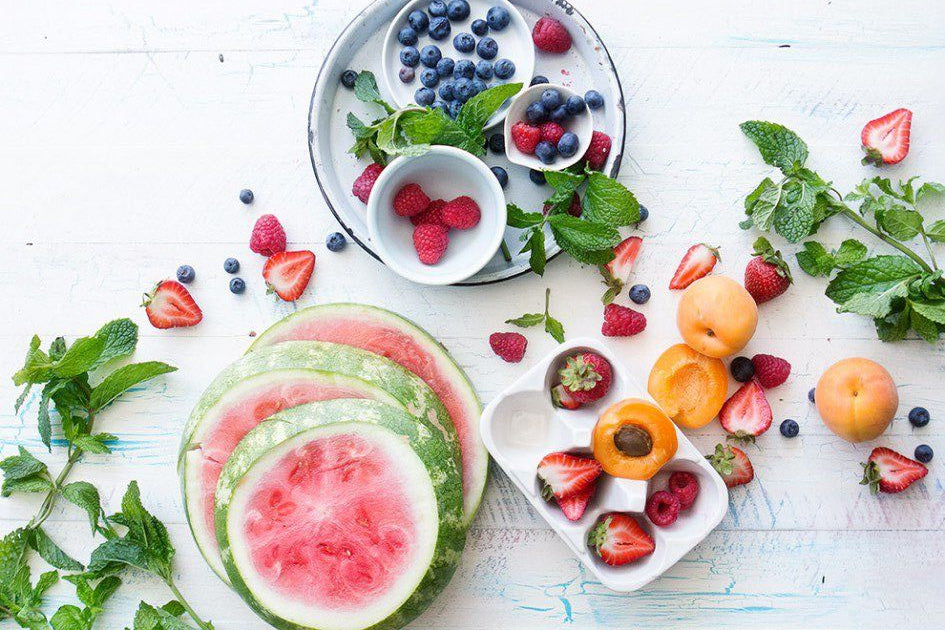
Eat Your Sunscreen: The Internal SPF Guide
How to Protect Your Skin from the Inside Out
Topical SPF is non-negotiable. But what you eat can also help your skin defend itself against sun damage.
At Skin Pantry & Apothecary, we believe skincare should be simple, functional, and food-grade. That’s where internal SPF comes in. Certain foods help your body resist UV damage, repair more quickly, and reduce inflammation at the cellular level. Others do the opposite, making your skin more sensitive and reactive.
Let’s break it all down, then give you delicious ways to start eating your sunscreen.
What Is Internal SPF?
Internal SPF refers to nutrients and compounds in food that help protect and repair skin from within. They don’t replace your mineral sunscreen, but they boost your resilience, calm inflammation, and enhance your skin barrier — all key to minimizing UV damage and aging.
These nutrients are usually rich in antioxidants, healthy fats, hydrating properties, and anti-inflammatory powers. Think of them as skin fuel that works around the clock.
The Nutrients That Help You Glow, Even in the Sun
Lycopene
Found in: Tomatoes, watermelon, red peppers
Lycopene is a powerful antioxidant that lives in the lipid layer of your skin and helps defend against UV damage. It reduces the depth of sunburn and protects cells from oxidative stress. Cooking tomatoes increases absorption, so spoon that marinara proudly.
Beta-Carotene
Found in: Carrots, sweet potatoes, spinach
This pigment converts to vitamin A, which helps your skin regenerate and stay resilient. Long-term intake can actually raise your skin’s baseline tolerance to sunlight. It also gives your skin a natural glow — no bronzer needed.
Vitamin C
Found in: Citrus, strawberries, kiwi, bell peppers
Vitamin C is your collagen co-pilot and antioxidant repair crew. It fights free radicals from UV exposure and helps your skin heal faster. Since your body doesn’t store it, a fresh daily dose is essential.
Vitamin E
Found in: Avocados, sunflower seeds, almonds
Vitamin E is a fat-soluble antioxidant that guards your skin barrier and reduces inflammation. It also keeps skin hydrated and supple, especially after sun exposure. When paired with vitamin C, it’s even more effective.
Polyphenols
Found in: Green tea, cacao, grapes, berries
These plant compounds help slow signs of sun-induced aging and reduce redness. Green tea polyphenols specifically can decrease the severity of sunburn and protect skin structure over time.
Omega-3s
Found in: Chia seeds, flax, walnuts, wild salmon
Omega-3s are anti-inflammatory fats that help reinforce your skin barrier. They make your skin less reactive, more hydrated, and better able to hold its structure — especially after UV exposure.
Astaxanthin
Found in: Wild salmon, shrimp, krill oil
This bright red pigment is one of nature’s most potent antioxidants. It improves skin hydration, elasticity, and UV resilience from the inside. It’s like your built-in skin supplement — no serum required.
Selenium
Found in: Brazil nuts, eggs, brown rice
Selenium helps your body produce glutathione, the master antioxidant that detoxifies cells and neutralizes UV damage. It’s essential for fast, effective repair and overall skin clarity.
What to Avoid If You Want Skin That Can Handle the Sun
Not all foods support your glow. Some actually make your skin more vulnerable to damage.
Refined Vegetable Oils
Found in: Canola, soybean, corn oil
These are high in omega-6s, which contribute to chronic inflammation when not balanced with omega-3s. That inflammation weakens your skin’s ability to repair and defend itself.
Try instead: Extra virgin olive oil, avocado oil, or coconut oil.
Excess Sugar
Found in: Sweets, sodas, processed snacks
Sugar damages collagen through a process called glycation, making your skin less elastic and more prone to sun aging.
Better option: Dark chocolate, fruit, or a drizzle of raw honey.
Alcohol (in excess)
Alcohol depletes vitamin C and glutathione, both critical for skin healing and antioxidant repair. It also dehydrates your skin, making it more reactive to sun exposure.
Swap with: Coconut water, herbal tea, or aloe mocktails.
Charred Meats
Cooking meat at high heat produces compounds that increase oxidative stress. That extra sizzle may taste good, but it doesn’t do your skin any favors.
Go for: Slow-roasting, steaming, or grilling with an antioxidant-rich marinade.
Too Much Caffeine
Overdoing it without hydrating can leave your skin dry and more likely to react to sun exposure.
Balance with: Water, mineral-rich foods, or green tea.
Your Internal SPF Recipe Kit
Food that feeds your glow, fuels your barrier, and actually tastes good.
Mini Glow Shield Smoothie
Sun protection in a glass
Ingredients:
- 1/2 cup frozen watermelon or papaya
- 1 small carrot, peeled and chopped
- Juice of 1/2 orange or 1/4 cup pineapple
- 2 tablespoons avocado
- 1 teaspoon chia seeds
- 1/2 teaspoon matcha or green tea powder
- Small pinch of turmeric + black pepper
- 1/2 cup coconut water or aloe juice
Optional: Collagen, astaxanthin, or trace minerals
Blend and sip. This is your morning glow-up.
Skin Shot: Daily Glow Elixir
Your concentrated antioxidant booster
Ingredients:
- 1 tablespoon aloe vera juice
- 1 tablespoon orange or pineapple juice
- 1/2 teaspoon olive oil
- 1/8 teaspoon matcha
- Pinch turmeric and black pepper
- Optional: 1–2 drops of trace minerals
Shake or stir. Take it like a wellness shot before sun exposure or as part of your morning ritual.
Sun Armor Salad
A bowl full of barrier support
Base:
- Baby spinach
- Roasted sweet potato
- Cherry tomatoes
- Avocado
- Sunflower seeds
- Wild salmon or sardines
- Handful of berries or grapes
Dressing:
Olive oil, lemon juice, Dijon mustard, turmeric, pepper, and sea salt.
XoXo,
Your Skin Chefs
